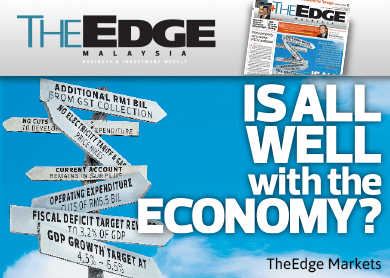

KUALA LUMPUR (Jan 24): The Edge weekly in its latest edition said Malaysians have been assured by the prime minister that the country is neither in a recession nor a crisis like that experienced in 1997/98.
But the magazine questioned if the country would be able to ride out the quagmire of falling crude oil and other commodity prices without suffering a twin deficit.
The Edge reported that Prime Minister Datuk Seri Najib Razak was clear in his revised Budget 2015 address last week: “We are neither in a recession nor a crisis [like that] experienced in 1997/98.” This message, which is meant to reassure the people, came together with a host of lowered economic indicators brought on mainly by circumstances that are beyond the government’s control.
“But is all really well with the economy?,” asked the Edge.
The magazine said the ripple effect of plummeting global crude oil prices over the last six months has exposed the vulnerability of the Malaysian economy. In June last year, oil prices were hovering at US$115 per barrel and now, they were more than halved to US$49.
It added that the perception of Malaysia being a large oil producer was debunked by the prime minister, given that the country is actually a net importer of petroleum after taking into account all petroleum products.
But it is undeniable that the plunge in crude oil prices will hurt oil exports, which in turn will impact oil-related revenue, it said.
Based on a more realistic crude oil price assumption of US$55 per barrel for the year compared with US$100 previously, oil revenue is expected to shrink to 21% of the total for 2015.
The Edge said falling oil prices were not the only problem for the country.
It ssid that globally, commodity prices were also on a downward trend.
“In 2013, Malaysia’s palm oil made up 6.4% of total exports and liquefied natural gas, 8.2%,” it said.
The decline in commodity prices has raised concerns of a twin deficit where both the current and fiscal accounts fall into negative territory. The national budget has been in deficit since the 1997/98 Asian Financial Crisis and was widest at -7% of gross domestic product (GDP) in 2009. While Najib has assured that a twin deficit will not arise, it is far from comforting to see the current account surplus shrink to 2% to 3% of gross national income from an estimated 5.1% a year ago.
The current account is made up of the trade balance and net income from abroad, as well as net current transfers.
Further, the slump in oil prices means that the fiscal deficit target of 3% of GDP for 2015 is now unachievable, and this was subsequently revised to 3.2%. It is worth noting that if the budget were not revised, the deficit would hit 3.9%.
The government also revised downwards the projected GDP growth forecast to 4.5% to 5.5% from 5% to 6% previously.
“These revisions underscore the vulnerability of Malaysia’s economy and credit profile to sharp movements in commodity prices. The high share of revenue linked to oil and gas is a structural weakness for the sovereign,” notes Fitch Ratings in a statement made after the budget revision. The rating agency is maintaining a negative outlook for Malaysia’s long-term issuer default rating, “which means that we are more likely than not to downgrade the rating within the next 12 to 18 months”.
It states that while the prime minister said he expects the current account to remain in surplus, the risks are “on the downside”, given the sharp decline in energy prices.
“The emergence of a twin deficit will remain a rating sensitivity for Malaysia,” it adds.
Could the country’s current account fall into a deficit? A deficit in the current account is the result of falling exports and/or rising imports along with outflows of income.
For a detailed analysis of the state of the nation’s economy, please read the Edge edition for the week of Jan 26 – Feb 1, now available at newstands.

Save by subscribing to us for your print and/or digital copy.
P/S: The Edge is also available on Apple's AppStore and Androids' Google Play.